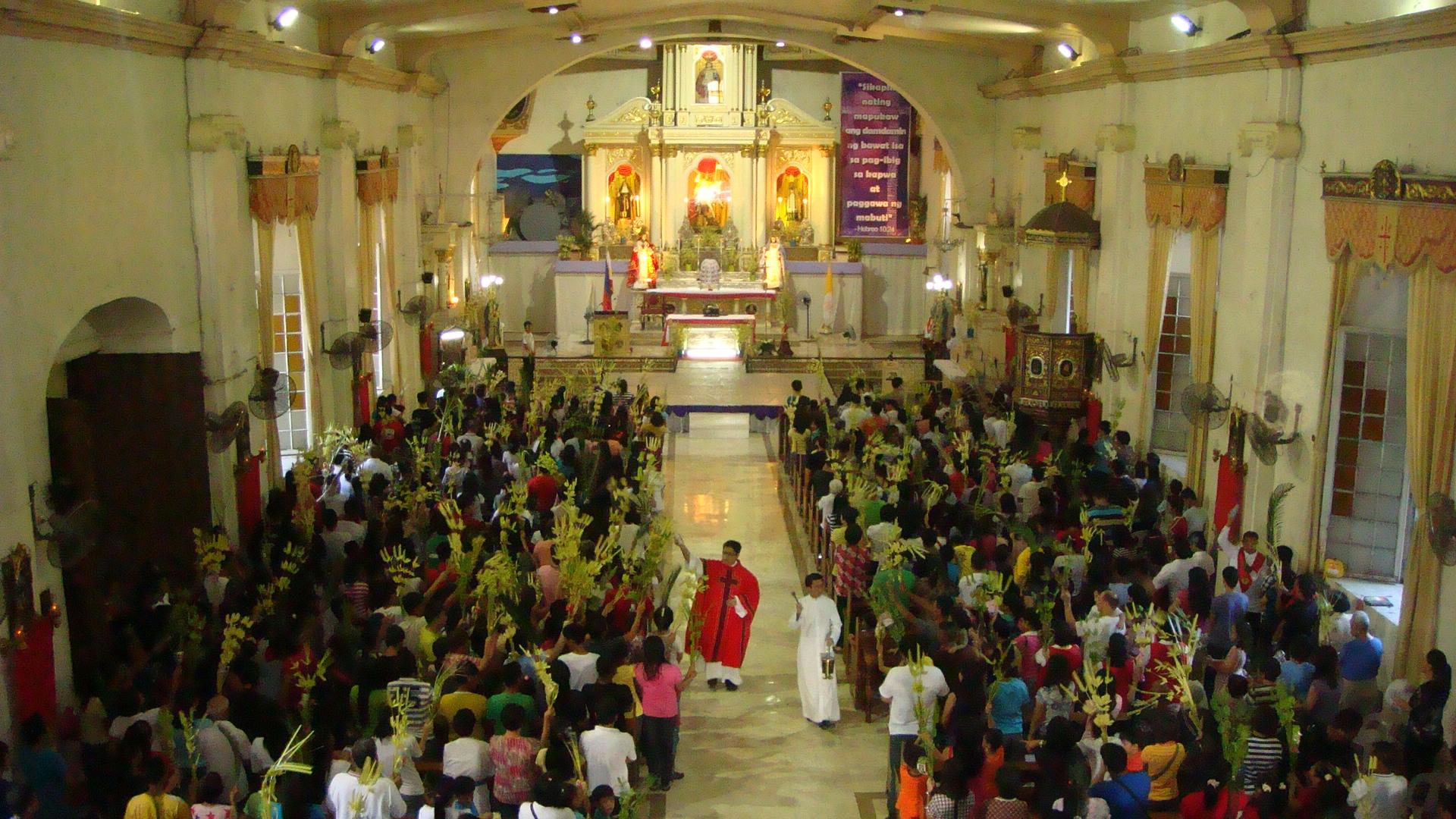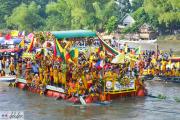
During the 2012 Palm Sunday at St. James the Apostle Parish Church, Plaridel, Bulacan
Holy Week, also known as Semana Santa in Spanish or Mahal na Araw in Filipino, is a very important event in the Philippines. Filipinos Catholics are known for their devotion, which is why they spend much effort and reverence during the celebration.
As a sign of respect, at the beginning of Maundy Thursday, businesses in the Philippines either shut down operations until Black Saturday or have later opening and earlier closing times. During the Easter Triduum, which is usually a public holiday, many local terrestrial television and radio stations close down out of respect, or have limited broadcasting hours. Those that do operate replace normal programming with special religious content, Filipino movies, documentaries, and news coverage of religious ceremonies. Many communities observe the Spanish-influenced Catholic rituals, such as processions, with many having been syncretised with pre-Hispanic beliefs. This is evident in local practises and the many superstitions associated with the occasion.
Palm Sunday
A mass celebration is conducted on Palm Sunday, also called as Linggo ng Palaspás or Domingo de Ramos, Catholics carry palm fronds to be blessed by the priest. Many Filipinos bring them home after the Mass and place them above their front doors or windows in the belief that doing so can ward off evil spirits and avert lightning. In some places, a procession is held, sometimes starting from an ermita/visita (Chapel of ease). Other parishes would have the priest bless palms in a plaza fronting or near the church.
Holy Wednesday
In the nearby provinces of Pampanga, Bulacan, Rizal and Laguna, a procession of the Passion of Christ is held during the evening of Holy Wednesday. Except for Baliwag and other small towns, scenes from the life of Jesus no longer join the Good Friday Procession.
San Pablo, Parañaque, Makati and Malabon used to have grand processions on Holy Wednesday. These were discontinued some years ago due to economic constraints (Makati has however revived the practice).
Maundy Thursday
Maundy Thursday (Huwebes Santo) is the beginning of the Triduum and represents the build-up of events for the week.
The main observance of the day is the last Mass before Easter (commonly called the Mass of the Institution of the Lord's Supper) usually including a re-enactment of the Washing of the Feet of the Apostles; this Mass is followed by the procession of the Blessed Sacrament before it is taken to the Altar of Repose.
Beginning in the morning, the faithful observe the "Visita Iglesia" or "Church Visit", which usually involves going to the seven churches to meditate on the Way of the Cross; by evening this includes a visit to the exposed Blessed Sacrament on the Altar of Repose.
Another tradition is when parishioners join their parish priest for the usual morning Mass in the cathedral, especially in the large dioceses and archdioceses. Many priests in the country consider this to be the day when they renew their sacerdotal vows. The bishop asks them: a) At your ordination, you accepted the responsibilities of priesthood out of love for the Lord Jesus and His Church. Are you resolved to unite yourselves more closely to Christ and try to become more like him by joyfully sacrificing your own pleasure and ambition to bring his peace and love, to your brothers and sisters?
This mass, which is presided by the bishop/archbishop of a particular diocese, blesses the Chrism, along with the oil of the catechumens and the oil of the sick after the homily and the priests bring the oils to their respective parishes after the Mass
Good Friday
Good Friday, or Biyernes Santo, is a public holiday, commemorated with solemn street processions, the Way of the Cross, the commemoration of Jesus' Seven Last Words or Siete Palabras, and a traditional Passion play called the Senákulo, which in some places is a week-long affair. In some communities, most famously in the province of Pampanga, the processions include devotees who self-flagellate and sometimes even have themselves nailed to crosses as expressions of penance, in fulfillment of a vow, or in thanksgiving for a granted request. The marathon chanting or "Pabasa" of the Pasyon, the epic narrative of Christ's Life, Passion, Death, and Resurrection, usually concludes on this day.
In the town of Paete, Laguna, a tradition wherein the Santo Entierro is smoked several times before the procession, using lansones peelings for the fire while someone shouts "¡Señor, Misericordia, Señor!" (Lord, Have mercy, Lord! in English, Panginoon, Maawa Ka, Panginoon! in Tagalog). This act would be repeated again during the procession.
Towards evening, there is a funeral procession of an image of dead Christ known as "Prusisyon ng Sto. Entierro". Often scenes from the Passion and Death of Jesus Christ precede the funeral cortege of Dead Christ borne on a carriage called "Calandra". Followed by the images of Salome, Mary of James, Mary Cleophas, Mary Magdalene, John the Evangelist and Mater Dolorosa.
Some places accord the statue of the Santo Entierro with proper funeral rites, such as laying the body in state. The public sorrow attributed to this day gave rise to the descriptive Tagalog idiom "Mukha kang Biyernes Santo", literally meaning "You look like Good Friday". This means that the subject looks so sad that he resembles the suffering Jesus Christ.
In Lipa City, Batangas, during midnight, a silent procession of the Santo Entierro is held for the burial in the nearest chapel of the parish. The Santo Entierro is accompanied by the Mater Dolorosa and St. John the Evangelist. The chapel serves as the tomb and locked until the midnight of Easter Sunday.
Unless required for health reasons, Filipinos tend to avoid taking a bath after 3 in the afternoon as a sacrifice, according to the belief that Jesus died at that specific hour.
Holy Saturday
Holy Saturday known locally as "Black Saturday" or Sabado de Gloria (Spanish: "Saturday of Glory"), has the traditional silence and solemnity from the previous day spill over. Preparations are made for the Easter Vigil to be celebrated that evening.
Some parishes have a presentation where Judas hangs himself because of his treachery towards Jesus.
Easter Sunday
Easter (Paskò/Linggo ng Pagkabuhay) morning is marked with joyous celebration, the first being the dawn ceremony called the Salubong (Filipino: "meeting"). The statues (normally life-sized or bigger) of the Resurrected Christ and the Virgin Mary, are brought in procession together to meet at a designated area called a "Galilea", usually located at the plaza fronting the church. It re-enacts the imagined reunion of Jesus and his mother Mary after the Resurrection. In some locales, statues of Mary of James, Mary of Cleophas, Salome, Magdalene and Saint John the Evangelist accompany the image of the Mother of God.
The Virgin Mary is clothed or veiled in black to express bereavement. A girl dressed as an angel, positioned on a specially constructed high platform/scaffold or suspended in mid-air, sings the Regina Coeli in Latin or in the vernacular and then dramatically removes the black veil, signifying the end of Mary's grieving. This is accomplished by other "angels" who simply pull off the veil, or tie it to balloons or doves and release these into the air. The Virgin is then called Nuestra Señora de Alegria, or Our Lady of Joy. The moment is marked by pealing bells and fireworks, followed by the Easter Mass. In several parishes, however, the practice is done on midnight of Easter Sunday immediately after the Easter Vigil itself.










